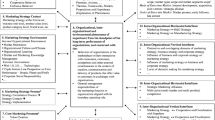Abstract
This study “links” Japanese purchasing agents’ attitudes of the United States and U.S. suppliers of products to buyer intentions. A Multiple Analysis of Variance procedure (MANOVA) is utilized to detect similar variances between attitudes and homogeneous demographics. The result of the research is a method that defines industrial market segments in Japan.
Similar content being viewed by others
References
Barnette, W. Leslie (1950), “The Nonrespondent Problem in Questionnaire Research,”Journal of Applied Psychology, 34 (December), 397–8.
Chiesl, Newell E. and Lawrence L. Knight (1981), “Japanese Buyers’ Attitudes Toward U.S. Supply Sources,”Industrial Marketing Management, 10 (October), 243–251.
Choffray, Jean-Marie and Gary L. Lilien (1980), “Industrial Market Segmentation by the Structure of the Purchasing Process,”Industrial Marketing Management, 9 (September), 331–342.
Choffray, Jean-Marie and Gary L. Lilien (1980),Market Planning for New Industrial Products. New York: Ronald Press Publication.
Claycamp, Henry J. and William F. Massy (1968), “A Theory of Market Segmentation,” V (November), 388–94.
Dichter, Ernest (1973), “Industrial Buying Is Dead on Some ‘Only Human’ Emotional Factors that Motivate Consumer Market’s Housewife,”Industrial Marketing, (February), 14–18.
Hall, Bob (1980), “Charting Japan’s Growth in the U.S. Auto Market,”Automotive News, (February 25), 2.
Hall, Bob (1980), “Japan: An Upsurge in Sales in Chips to U.S.,”Business Week, (February 18), 79.
Japan Company Handbook (1979), First Half Edition, Tokyo: Toyo Keizai Shinposa, Ltd.
Johnson, Hal G. and Ake Flodhammer (1980), “Some Factors in Industrial Market Segmentation,”Industrial Marketing Management, 9, 201–205.
Lehman, Edward C. (1963), “Tests of Signifcance and Partial Returns to Mail Questionnaires,”Rural Sociology, 28 (September), 284–9.
Lehmann, Donald R. and John O’Shaughnessy (1974), “Differences in Attribute Importance for Different Industrial Products,”Journal of Marketing, Vol. 38 (April), 36–42.
MacLachlan, Douglas L. and Johny K. Johansson (1981), “Market Segmentation with Multivariate Aid,”Journal of Marketing, 45 (Winter), 74–84.
Michman, Ronald D., M. Gable, and W. Gross (1977), “Market Segmentation: A Selected and Annotated Bibliography,” AMA.
Ognibene, Peter (1971), “Correcting Nonresponse Bias in Mail Questionnaires,”Journal of Marketing Research, 8 (May), 233–5.
O’Shaughnessy, John and Donald R. Lehmann (1975), “‘A Rely to’ a Cautionary Note on ‘Difference in Attribute Importance for Different Industrial Products’,”Journal of Marketing, Vol. 39 (January), 80.
Sheth, Jagish, N. (1973), “A Model of Industrial Buyer Behavior,”Journal of Marketing, Vol. 37 (October), 50–56.
Shoaf, Robert F., Ed., (1959),Emotional Factors Underlying Industrial Purchasing. Cleveland: Penton Publishing Company.
Smith, Wendell (1956), “Product Differentiation and Market Segmentation as Alternative Marketing Strategies,”Journal of Marketing, 21 (July), 3–8.
Stanton, William (1981),Fundamentals of Marketing, 6th Edition, (New York: McGraw-Hill), 473.
United States Bureau of Census, Highlights of U.S. Exports and Import Trade, Washington, D.C. (1960–1980).
Upah, Gregory D. and Monroe M. Bird (1980), “Changes in Industrial Buying: Implications for Industrial Marketers,”Industrial Marketing Management, (May), 331–342.
Webster, Frederick E., Jr., and Yoram Wind (1972), “A Generic Model for Understanding Organizational Buying Behavior,”Journal of Marketing, Vol. 36, No. 2 (April), 12–19.
Wiegner, Kathleen K. (1980), “Xerox, Here We Come (Canon),”Forbes, 125 (March 31), 117.
Wind, Yoram and Richard Cardozo (1974), “Industrial Market Segmentation,”Industrial Marketing Management, 3, 153–166.
Wind, Yoram (1978), “Issues and Advances in Segmentation Research,”Journal of Marketing Research, XV (August), 317–37.
Yahn, Steve (1977), “Can U.S. Television Set Marketers Survive,”Advertising Age, 48 (April 25), 85.
Yankelovich, Daniel (1964), “New Criteria for Market Segmentation,”Harvard Business Review, Vol. 42 (March–April), 83–90.
Author information
Authors and Affiliations
Rights and permissions
About this article
Cite this article
Chiesl, N.E., Lamb, S.W. Segmenting international industrial markets. JAMS 11, 250–258 (1983). https://doi.org/10.1007/BF02725221
Issue Date:
DOI: https://doi.org/10.1007/BF02725221




